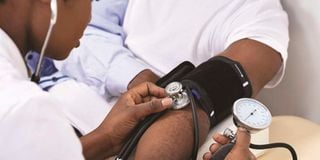Diet and lifestyle choices that prevent high blood pressure

Make sure the blood pressure cuff is snug but not too tight.
What you need to know:
Eat fresh veggies like broccoli, spinach, lettuce and sukuma wiki, as well as fruits such as apples, oranges, papayas, and watermelon.
High blood pressure is a silent killer. It can creep on you without knowledge, might kill you or it might set you up for chronic diseases such as cardiovascular disease. However, you can be in a better position to cope by learning the steps to managing high blood pressure and how this condition is treated. According to the World Health Organization (WHO), the preventive steps you need to take include:
Reducing salt intake: However, do not avoid taking sodium totally as it helps maintain body fluid balance. Reduce your intake to less than 5 grams per day.
Eating more fruit and vegetables: Eat fresh veggies like broccoli, spinach, lettuce, and sukuma wiki, as well as fruits such as apples, oranges, papayas, and watermelon.
Being physically active on a regular basis: The Centre for Disease Control (CDC) recommends that people aged 18 years and above get at least 2 hours and 30 minutes of moderate-intensity exercise. This might include brisk walking or bicycling, every week. The physical exercises should amount to about 30 minutes a day for five 5 days a week. Children and adolescents should get 1 hour of physical activity every day. You are considered overweight when the BMI (Body Mass Index) is more than 25, while a BMI of 30 or more means that you are obese.
Avoid the use of tobacco including cigarette smoking: Smoking raises your blood pressure and puts you at higher risk for heart attack and stroke.
Reducing alcohol consumption: The CDC recommends that men should have no more than 2 alcoholic drinks per day, and women should have no more than 1 alcoholic drink per day.
Regularly test for blood pressure: You can measure this at home with a home blood pressure monitor, or you can visit your doctor or nurse to have your blood pressure checked. A spot check on local e-commerce site Jumia shows that a home blood pressure monitoring kit costs between Sh. 2,000 and Sh. 2,500.
Increase intake of dietary fibre: This will help to lower blood cholesterol. It is recommended that you take about 20 to 35 grams of dietary fiber every day. Foods with high fibre content include breakfast cereals, whole grain bread, and vegetables.
Eat more fish: Eating plenty of fish, especially if you are on a weight loss program, will keep high blood pressure under control.
When diagnosed with high blood pressure, the WHO recommends
- Reducing and managing stress levels.
- Getting adequate treatment for high blood pressure from a licensed medical practitioner and medical institution.
- Managing any other medical condition you might have.
In the same vein, clinical nutritionist Lina Njoroge says avoiding or limiting these foods will keep high blood pressure at bay, and or manage it if you have already been diagnosed with it. Ms. Njoroge lists the foods as follows:
- Canned foods: These include soups packed with too much salt, canned tomato sauce, and canned tomato juice.
- Bacon: A slice of bacon has enough sodium. Limiting the number of slices you eat. These include things such as the BLT sandwich of bacon, lettuce, and tomato.
- Red meat: Keep a limit on the portions of red meat you consume.
- Whole milk: Milk is healthy and one of the greatest sources of calcium. But if you are hypertensive you should avoid it because it contains high levels of fat which is linked to heart disease.
Quick takeaway: Categories of high blood pressure
According to the Centre for Disease Control, your blood pressure will fall within in of these categories:
Blood Pressure Category | Systolic Blood Pressure | Diastolic Blood Pressure |
Normal | <120 mmHg | <80 mmHg |
Elevated | 120-129 mmHg | <80 mmHg |
Hypertension | ||
Stage One | 130-139 mmHg | 80-89 mmHg |
Stage Two | ≥140 mmHg | ≥90 mmHg |
The CDC cautions that you should take care not to get the wrong readings. For example, cites the CDC,
- What you ate, drank, or did before your reading can compromise the accuracy of the readings. If you smoked, drank alcohol or caffeine, or exercised within 30 minutes of having your blood pressure measured, your reading might be higher. Don’t eat or drink anything 30 minutes before you take your blood pressure.
- How you are sitting when taking your test? Crossing your legs and letting your arm droop at your side rather than rest on a table at chest height can make your blood pressure go up. Put both feet flat on the ground and keep your legs uncrossed.
- How do you position the blood pressure monitoring cuff? Make sure the blood pressure cuff is snug but not too tight. The cuff should be against your bare skin and not over your clothing.




